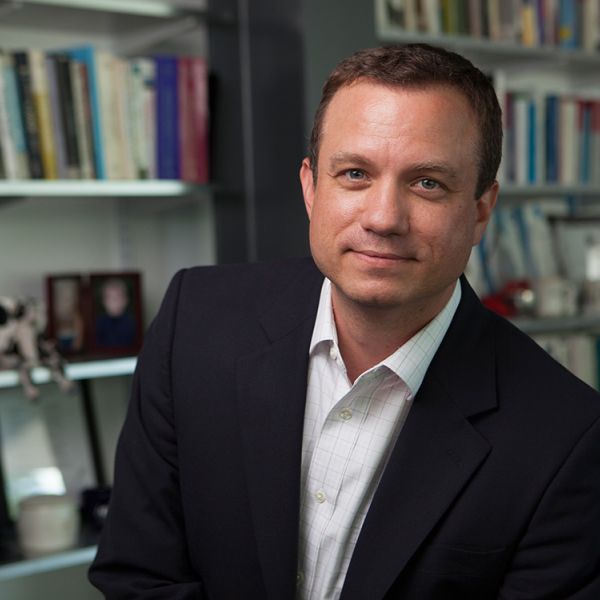This article is excerpted from Dean Greg Morrisett’s speech to the Cornell Board of Trustees in October 2016 about Computing and Information Science’s connection to Cornell Tech.
I want to speak to the vision of “One Cornell” that President Rawlings raised in his State of the University address. In particular, I want to say a few words about how the Cornell Tech campus is closely connected to our Ithaca campus, particularly within the context of Computing and Information Science (CIS).
Cornell’s CIS has 50 faculty in Ithaca, split across its three departments of Computer Science (CS), Information Science (IS), and Statistics (DSS). But now we have another 15 CS and IS faculty in New York City, so these two departments literally span the state. We have spent the past few years working to keep the CS and IS departments coherent as the faculty and students work across the two sites, while at the same time taking advantage of the unique resources, capabilities, and missions of the two campuses.
Let me first speak to key differences: In Ithaca, a primary focus has been and always will be on undergraduate, residential education. Undergraduate enrollment in CIS classes is booming because Cornell students realize that no matter what field of study they pursue, from art to zoology, some knowledge of computation, probability and statistics, and technology is vital to function in the modern world. To give you a feel for how fast we’re growing, three years ago we had about 400 majors total. Today, we have over 1,000. One of my priority goals is to make sure we can meet this demand at the undergraduate level, and give students the best experience possible.
While undergraduates are a crucial component here, in contrast, Cornell Tech is focused exclusively on graduate training. There, the curriculum intentionally mixes technical, engineering students with MBAs and now law students in a shared, studio environment. Being in New York gives us direct access to a vibrant tech scene, so that we can easily bring in current practitioners, such as CTOs and entrepreneurs to engage students.
Let me now speak to how we keep the two campuses connected, and some of the more exciting developments that have arisen in the past year: First, it is important to understand that each faculty member on the Tech Campus is a member of a department on the Ithaca campus and are involved in matters of curriculum and tenure decisions across the unit.
PhD students and post-docs are also a critical component of how we stay connected to Cornell Tech. When potential PhD students come to visit, they see both the Ithaca and New York sites. When the CS students start the PhD program, they first spend a year in Ithaca working on core courses, and then, if they choose to work with a faculty member in New York, transition to that environment. All our core PhD courses span both campuses. A student in Ithaca can take a course being fielded in New York through our connected classrooms in Gates Hall. Faculty regularly travel between the two sites so that students can have in-person experience, no matter where they are.
Perhaps the most important glue that holds the Cornell Tech and Ithaca CIS faculty together is the research that spans the two campuses. For example, we are doing the leading research on cryptographic-currencies, such as Bitcoin. Faculty Emin Gün Sirer, Andrew Myers and Elaine Shi here in Ithaca and Ari Juels, Rafael Pass and James Grimmelmann in New York have formed a campus-spanning research group focused on next-generation crypto-currencies and contracts.
In addition, Deborah Estrin, based in New York, and Tanzeem Choudhury, based in Ithaca, are working in conjunction with Weill Medical on new wearable and mobile technologies to address issues of health and wellness. Serge Belongie, based in New York, has worked with the Cornell Lab of Ornithology to develop the Merlin app, which automatically identifies the species of a bird using deep learning and gives the Lab valuable information on the location of species and their migration patterns. Jon Kleinberg, here in Ithaca, and Helen Nissenbaum, whom we just hired in New York, are looking at ethical issues at the interface of technology and society. For example, Jon just recently co-authored a paper that was highlighted in The Washington Post. That paper sheds light on recent controversies about the potential for bias in algorithmic risk tools used in the criminal justice system.
Of course, Cornell has always spanned the state of New York from the Ag School’s Geneva station and extension efforts to the medical school in the city. The Tech Campus adds a brilliant new dimension to this federation, one that’s vital to the future, not just for CIS, but the rest of Cornell and indeed the state of New York. A crucial element is the way we are integrating tenure-track faculty from multiple departments across both the Ithaca and New York campuses.
What I find exciting about the Tech Campus is that now we have the best of both worlds: one environment where we continue to focus on students as well as foundational research and another where we are experimenting with new educational models and can take advantage of direct engagement with industry, government, and the broader world. This allows us to attract the very best researchers and students in the world.



